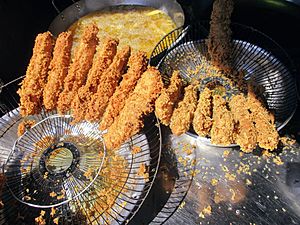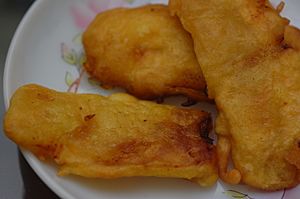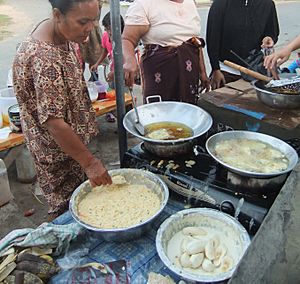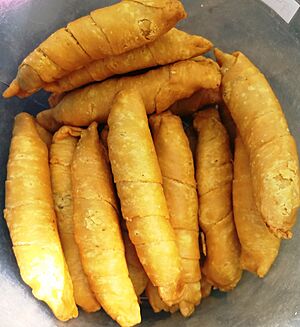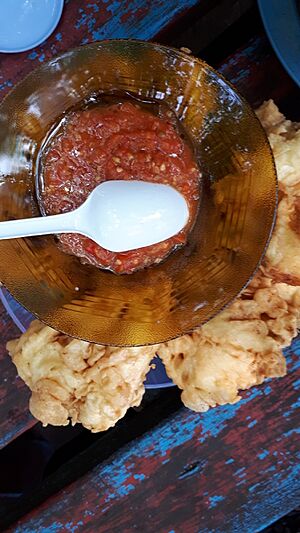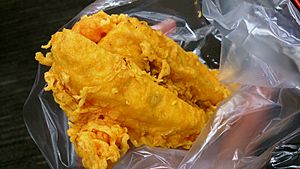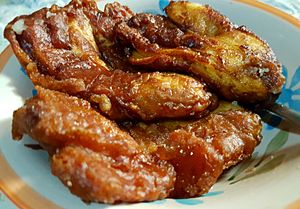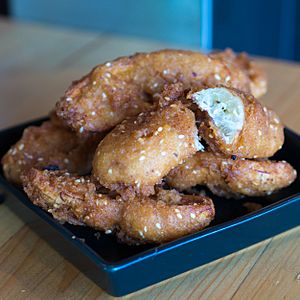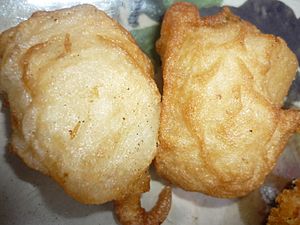Banana fritter facts for kids
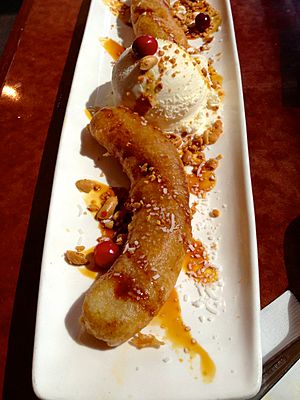
Banana fritter served with coconut shavings, peanuts and vanilla ice cream
|
|
| Type | Fritter |
|---|---|
| Region or state | Southeast Asia and the Indian subcontinent |
| Main ingredients | Banana or plantain, batter |
A banana fritter is a yummy snack! It's made by dipping slices of banana or plantain in a special batter, then frying them until they're golden and crispy. You can find this popular treat all over Southeast Asia and the Indian subcontinent.
Banana Fritters: A Sweet Treat Around the World
Banana fritters are enjoyed in many different countries. Each place has its own special way of making them! Let's explore some of these delicious varieties.
Brunei's Cucur Pisang
In Brunei, banana fritters are a traditional snack called cucur pisang. They are quite similar to the pisang goreng found in Indonesia and Malaysia. A special kind, cucur pisang madu, is made with honey. People in Brunei love to eat these honey banana fritters as a light afternoon snack.
Cambodia's Num Chek Chien
In Cambodia, banana fritters are known as num chek chien (នំចេកចៀន). To make them, bananas are flattened and dipped into a thick batter. This batter is made from rice flour, sesame seeds, egg whites, and coconut milk. It's seasoned with salt and sugar. Then, the fritters are deep-fried until they are crispy and golden.
Cambodian banana fritters are often more savory than sweet. They are usually eaten as a snack. A popular way to enjoy them is with coconut ice cream. There's even a famous shop in Cambodia called Chek Chean Pises that has been selling these tasty treats since 2000!
South India's Pazham Pori
In South India, especially in Kerala, you'll find a popular fritter called vazhakkappam or pazham pori (Malayalam: പഴം പൊരി). It's also known by other names like ethakka appam. This snack is made with ripe banana or plantain and maida flour.
Pazham pori is usually made from bananas or plantains. The plantains are sliced lengthwise after peeling. Then, they are dipped into a batter made from all-purpose flour, salt, turmeric powder, and sugar. Finally, they are deep-fried in oil until they turn golden brown. In other South Indian states like Karnataka and Tamil Nadu, they are sometimes made using besan flour instead.
People often enjoy pazham pori with tea or chai in the evening. In some places, you might even find it served with beef!
Indonesia's Pisang Goreng

In Indonesia, banana fritters are widely known as pisang goreng. You can often buy them from street vendors. These fritters are deep-fried in lots of cooking oil. They might be coated with a batter, or sometimes they are just fried plain.
People often use plantains instead of regular bananas for pisang goreng. Some popular types of bananas for this dish include pisang raja, pisang tanduk, and pisang kepok. These bananas have a slightly sweet and sour taste and a firm texture. This means they won't fall apart when fried. Pisang raja is a bit softer and has a lovely smell.
The batter usually mixes different kinds of flour, like wheat, rice flour, tapioca, or bread crumbs. Some recipes even add coconut milk or milk and vanilla to make the fritters smell extra good.
Most traditional street vendors sell pisang goreng plain, without any extra toppings. But in fancier coffee shops and restaurants, you might find more special versions. These can be sprinkled with powdered sugar, cinnamon sugar, cheese, or even served with jam, condensed milk, chocolate, or vanilla ice cream!
In Indonesia, pisang goreng is a favorite snack to have with tea or coffee. People enjoy it in the morning or during an afternoon break. Local coffee shops often offer pisang goreng and other fried snacks to go with your drink.
Pisang goreng is sold by street vendors all over Indonesia, often alongside other fried foods. Besides banana fritters, you can find fried tempeh, tofu, sweet potato, and vegetables.
Each region in Indonesia has its own special way to make pisang goreng. They might have different names, ingredients, or cooking methods. For example, in Bali, it's called godoh biu. In West Java, it's cau goreng. In Pontianak, it's known as pisang kipas.
Types of Pisang Goreng
Indonesia has many exciting varieties of pisang goreng:
- Pisang goreng kipas or Pisang goreng Pontianak: These are bananas cut into a fan shape, battered, and deep-fried. Pisang goreng Pontianak often has a filling or is served with kaya jam.
- Pisang goreng pasir: This means "sandy fried banana." Bread crumbs are added to the batter. This gives the fritter a crunchy, grainy outside, similar to a croquette.
- Pisang goreng kremes: This Javanese version is like pisang goreng pasir but uses a different batter. The batter is made with rice flour, vanilla, and coconut milk. When fried, it creates crispy, crunchy bits called kremes on the outside.
- Pisang goreng madu: Meaning "honey fried banana," this version has honey mixed into the batter. More honey is often drizzled on top before serving. The honey makes the fritter a darker color.
- Pisang molen: This type is inspired by Dutch cooking. Instead of a batter, the banana is wrapped in thin pastry dough before frying. This makes the outside crunchy like a pastry, while the banana inside stays soft.
- Pisang cokelat: Often called piscok, this is a thin crepe skin filled with banana and chocolate sprinkles or chocolate milk. It's folded and deep-fried like a spring roll. It's very similar to the Filipino turon.
- Pisang embal: This Kei pisang goreng uses embal (tapioca or cassava starch) in its batter. It's served with sambal, a spicy chili paste.
- Pisang nugget: These are small, nugget-shaped fried bananas. They are coated in bread crumbs, like pisang goreng pasir, but are much smaller, similar to chicken nuggets.
- Pisang goreng telanjang: This means "naked fried banana." It's fried without any batter. Salted butter or margarine is added, and it might be topped with grated cheddar cheese.
- Pisang goreng Manado: This Manado pisang goreng is like other battered fritters, but it's served with sambal roa. This is a spicy chili paste made from smoked roa fish and fresh chilies.
Malaysia's Pisang Goreng
In Malaysia, banana fritters are also commonly known as pisang goreng in Malay language. Other names include cekodok pisang and jemput-jemput pisang. The Malaysian style is made by deep-frying battered plantain in hot oil. People typically eat them as a snack in the morning and afternoon. You can often buy them from street vendors, but they are also sold in shops and restaurants.
Philippines' Fried Bananas
The Philippines has many different fried banana dishes! They are almost always made from saba bananas, a special cooking banana often used in Filipino cuisine. Pritong saging are fried saba bananas (without batter) usually served with sugar or syrup.
Bananas cooked with batter are called maruya. These are often made by mashing the bananas or slicing them very thinly and spreading them into a fan shape. However, the most common Filipino street food made from banana are banana cue and turon. Banana cue are fried bananas coated with caramelized sugar and served on skewers. Turon is a fried dessert that is wrapped in a thin crepe-like wrapper, similar to a spring roll.
Thailand's Kluai Khaek
Kluai khaek (Thai: กล้วยแขก) is a very popular Thai street snack. It's sometimes called kluai thot (กล้วยทอด). Kluai khaek is made from fried, floured banana and often topped with white sesame seeds.
The word kluai in Thai means "banana." The word khaek is an old term sometimes used for people from India or the Middle East. It's thought that this dish might have come from their recipes.
Today, kluai khaek is a common street food that you can easily find at many stalls. It's often sold with other similar snacks, like fried taro.
Suriname's Bakabana
In Suriname, this tasty snack is known as bakabana. This name means "baked banana" in the Surinamese language.
Vietnam's Chuối Chiên
In Vietnam, banana fritters are called chuối chiên. They are inspired by a French dessert called banana flambée. After being deep-fried, Vietnamese banana fritters are often drizzled with rum or rice wine. Then, they are lit on fire briefly to make them even crispier!
Images for kids
-
Piscok, pisang goreng with chocolate


